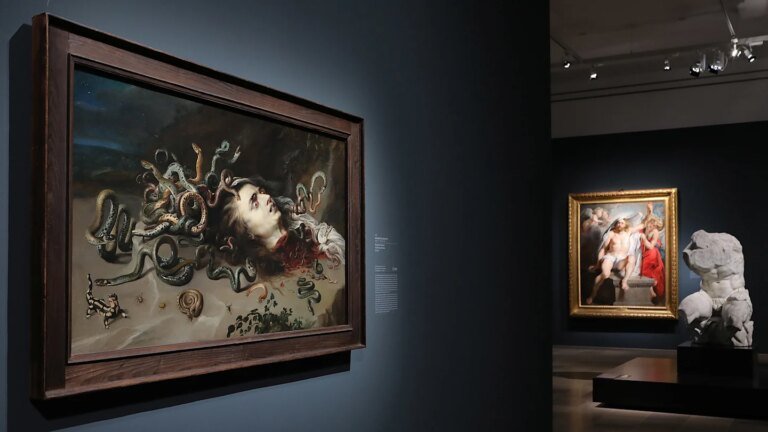The power of fear has been vividly depicted by some of history’s greatest painters. Some of the alarming visions conjured by these artists have been drawn from mythology and religion, while others are mirrors of horrifying experiences drawn from the real world. Here’s a chronological look at six of history’s scariest paintings.
- Hieronymus Bosch’s The Garden of Earthly Delights (1490–1500)
- Peter Paul Rubens’s Medusa (1617–18)
- Henry Fuseli // The Nightmare (1781)
- Francisco Goya // The Third of May 1808 (1814)
- Edvard Munch // The Scream (1893)
- Salvador Dalí // The Visage of War (1940)
Hieronymus Bosch’s The Garden of Earthly Delights (1490–1500)

The Dutch artist Hieronymus Bosch is known for his visions of the grotesque and the terrifying, and one of his most famous works is the triptych painting The Garden of Earthly Delights. When closed, the painting forms a diptych of seemingly calm images showing Earth in the early days of its creation; it’s only when the painting is unfolded that we see Bosch’s vision of terror.

The left hand panel portrays humans progressing from creation with images evoking the Biblical story of Adam and Eve. Next, on the central section, comes mortal pleasures on earth. Finally, on the last panel is a hell-like place where people are tortured by monsters. The final panel includes disturbing imagery of people being tortured by instruments, eaten by a bird-bug creature, and crushed by ears.
The oldest painting on this list, The Garden of Earthly Delights has continued to have a profound influence on art over the centuries and endures to the present day—its influence continues to be seen in a number of contemporary artworks.
Peter Paul Rubens’s Medusa (1617–18)

In ancient Greek mythology, Medusa was originally a mortal woman who was cursed by the goddess Athena to have snakes in her hair and the ability to turn men to stone with a glance. Eventually, she was destroyed by Perseus, who cut off her head. Medusa’s story has inspired many artists over the centuries, including Leonardo, Caravaggio, and Peter Paul Rubens, whose painting depicts the aftermath of the decapitation. The details of the painting—the writhing snakes, the blood at her neck, her horrified expression—makes it one of the most haunting visual interpretations of the myth.
Dutch poet Constantijn Huygens, a correspondent of Rubens’s, wrote in his memoirs that Reubens “has composed the sight of a marvellously beautiful woman, who is still attractive but also causes horror because death has just arrived and evil snakes hang around her temples, with such inexpressible deliberation, that the viewer is suddenly caught by terror.”
You Might Also Like …
Add Mental Floss as a preferred news source!
Henry Fuseli // The Nightmare (1781)

Henry Fuseli was a Swiss-born artist who worked in Britain in the late 18th and early 19th century. The Nightmare, one of his most famous works, portrays a woman lying asleep with a gargoyle-esque monster squatting on her stomach; a horse-like creature with bulging eyes peers from around a translucent curtain, through which the silhouette of another monster can be glimpsed lurking in the background. The painting went on public display for the first time at the Royal Academy in London in 1782 and caused quite the stir: The event was described as both “a scandal, and a success.” The Nightmare would go on to become a widespread motif in the visual arts.
Francisco Goya // The Third of May 1808 (1814)

While Francisco Goya painted a number of frightening supernatural scenes, such as Saturn Devouring His Son, he also painted real-life horrors in works like the Disasters of War series, which includes The Third of May 1808. The painting, which depicts the execution of Spaniards resisting the invasion of Napoleon during the Spanish War of Independence, shows a terrified man facing those about to shoot him while flinging out his arms in defiance. Other figures in the painting also show their fear as they try to shield themselves from the imminent bullets.
In works like The Third of May 1808, Goya sought to represent the terror felt by his compatriots in the face of violence and oppression and the threat of death and destruction, but also the bravery in the acts of resistance against them.
Edvard Munch // The Scream (1893)

One of the most famous depictions of fear in the history of art, Edvard Munch’s The Scream actually exists in multiple versions: the artist created two paintings as well as two pastel works portraying versions of the same scene. The Scream depicts the artist’s feelings of intense anxiety one day when out for a walk with friends, and his sense of being overwhelmed by his environment (including an ominous red sky that is vividly represented in the painting).
But something that’s widely misunderstood about The Scream is that the person is the one who is screaming themselves. That’s not the case: Munch later said wrote that the scream was intended as being felt through the surroundings (“I felt a large scream pass through nature”) and the figure at the center is actually trying to block out the sound by putting their hands over their ears, not making the sound themselves.
Salvador Dalí // The Visage of War (1940)
Like Rubens, Salvador Dalí took visual inspiration from the mythological story of Medusa in his work, including in the 1940 painting The Visage of War. When he was creating the work, the Spanish Civil War had recently taken place and the Second World War was underway. The painting shows the image of Medusa’s face with gaping holes at the eyes and mouth; within each of these gaps is a miniature version of the whole face, with a series of faces within faces in each.
Through this visual device, Dalí expresses the ongoing terrors created by the destructiveness of war and evokes the sense of a person who has been hollowed out by the horrors they’ve witnessed, elements of which Dalí had personally experienced during his flight from Europe in 1940 as war swept over the continent.





